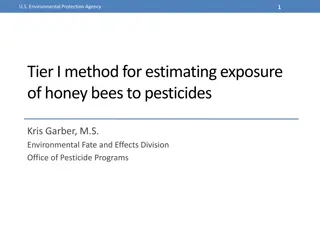Understanding the Social Life of Bees
Honeybees exhibit highly organized social behavior within their colonies, comprising a queen, drones, and worker bees. The queen lays eggs and emits pheromones to regulate worker behavior. Worker bees collect nectar to produce honey, a beneficial substance rich in essential nutrients. Various species of bees exist, including Apis indica and Apis mellifera. Drones, the male bees, serve the sole purpose of mating with the queen.
Download Presentation

Please find below an Image/Link to download the presentation.
The content on the website is provided AS IS for your information and personal use only. It may not be sold, licensed, or shared on other websites without obtaining consent from the author. Download presentation by click this link. If you encounter any issues during the download, it is possible that the publisher has removed the file from their server.
E N D
Presentation Transcript
In this topic we will discuss about the social behaviour of honeybees :- Honey bees have developed one of the most highly organised societies. They live in colonies. The colonies of the honeybees are perennial and a good colony of honeybee may consist of 50000 to 80000 individuals. It comprises of one fertile female or the queen , a few hundreds of male bees or drones and the rest are sterile females or worker.
The queen lays the eggs which develops into few workers, drones and queens . She also emits a complex series of chemical secretions, the pheromones that regulate much of the behaviour of the workers. Both queen and worker are genetically diploid. Queens , however , are fed a special rich larval food; a white ,foamy ,yogurt-like royal jelly. It is necessary for normal queen size and sexual development
Workers too , can develop into sexually reproducing females , but their reproductive organs are kept undeveloped through the effect of queens pheromones. Drones are genetically haploid and are produced by the laying of unfertilized eggs by parthenogenesis. Drones are generally produced at the same time as the new queen . Honeybees are the colonial insects visiting flowers to collect nectar and convert it into a golden yellow aromatic viscous fluid called honey popularly known as the liquid gold of nature.
Honey contains about : 80% sugars Mainly glucose and fructose . Harmful sucrose is only 1.2% in honey . In addition , honey contains all essential vitamins ,minerals and proteins . It has antiseptic properties and is a good blood purifier. It removes gastric problems and corrects metabolic imbalances in the body.
Four species of bees are identified . They are- Apis indica , Apis melifera , Apis dorsata ,Apis florea
Males or the Drones Drones are intermediate in size but considerably stouter and broader. They possess large eyes ,small pointed mandibles and lack wax producing glands ,pollen collecting apparatus and a sting . The drones do not any work and if fed by the workers they die . They exist only to mate with the queen .
Worker The worker honeybee is the smallest member of the colony . It is black or brown in colour and its mouth parts are of the rasping and lapping type , to facilitate the collection of nectar and pollen . The legs are covered with hair and are adapted for gathering pollen . The meso thoracic legs bear a pollen brush and a spine like pollen spur to remove pollen from pollen baskets .
The meta thoracic legs has a depression called the pollen basket . The last four visible segments of the abdomen have modified cells on the ventral surface that secretes wax , which is essential for making the hive.
Queen The queen being the only fertile female of the hive ,have highly developed ovaries . The queen is elongated with a long tapering abdomen with comparatively shorter wings and legs. She has pointed mandibles and shorter mouth parts and sting with no barbs . She alone lays eggs and is the mother of almost all the members of the hive .
She lives for several successive years laying about 1 200 eggs a day and laying about 15 lakh eggs during her life time . When a hive of honey bees prepare to swarm or when an old queen becomes weak , the regulating pheromones of queen also become weak .























